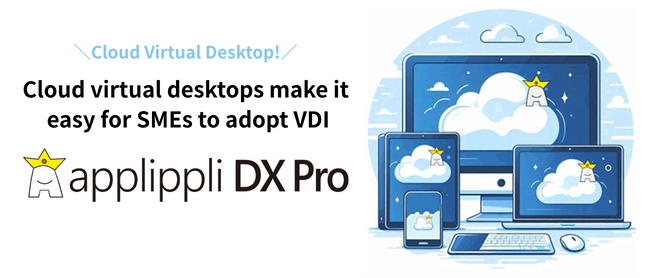How to do telework? Explaining the merits and demerits of virtual desktops

Teleworking has been a hot topic since many companies introduced it to carry out work from home during the COVID-19 pandemic, and I think many people want to know how to do it.
Teleworking not only allows you to work from home, but also allows you to work from anywhere and expand employment, so many companies continue to introduce teleworking even now, when the COVID-19 pandemic is no longer in effect.
While teleworking has many benefits, I think there are many people who do not know how to do it.
In fact, teleworking can be easily implemented if you use something called a “cloud virtual desktop.”
In this article, we will explain how to telework, including a discussion of virtual desktops.
Updated March 24, 2025
| What is telework? |
Telework is a flexible way of working that makes effective use of time and place by utilizing information and communication technology (ICT). It is a coined word that combines tele (away) and work (work). In short, it means working using ICT at a location away from the main office. Telework is valued as a means of work style reform because it allows for a “work style that is not tied to location.” In addition, because it reduces “contact between people,” it has also been attracting attention in recent years as an effective means of preventing the spread of infectious diseases such as COVID-19. Telework can be classified from the perspective of “place of work,” into “telecommuting,” where you work from home; “satellite office work,” where you work at a facility other than your home base; and “mobile work,” where you work while traveling or on the go. Source: Ministry of Health, Labor and Welfare Telework Comprehensive Portal Site (https://telework.mhlw.go.jp/telework/about/) |
Difference between remote work and telework
You probably often hear the word remote work, which is similar to telework.
Do you know the difference between these two words?
In fact, there is almost no difference in meaning.
If I had to say, it would be that telework is a word that has existed for a long time, while remote work is a word that was created by itself.
How to telework

There are several ways to telework, but this time we will explain how to telework using a “virtual desktop (VDI)” service.
Virtual desktop (VDI)
A virtual desktop (VDI) is a method of creating a desktop environment on a server and operating that desktop environment from a remote location.
There are two types of virtual desktops:
In addition to the virtual desktop we will explain this time, there is also a system that creates multiple desktops on a Windows desktop.
Please note that this Windows virtual desktop and virtual desktop (VDI) are different things.
Merits of introducing telework with a virtual desktop (VDI)

So, what are the merits of introducing telework with a virtual desktop (VDI)?
The merits are as follows:
| Merits |
|
The same tasks can be performed from any machine
Each company has its own reasons for introducing teleworking, but many people would enjoy the merits of being able to perform the same tasks from any device or PC.
Not only does it allow people to work from home in situations like the COVID-19 pandemic, but area managers, who are common in the apparel industry, will be able to perform the same tasks from any computer in the stores in their area, eliminating the need to carry a computer with them.
Another merit is that it protects data from natural disasters such as earthquakes and lightning strikes (BCP measures).
If the office were to collapse in an earthquake, it would be extremely difficult to retrieve data that was stored on the office server.
However, if you store your data in a virtual desktop environment, your data will be protected and you can resume work as soon as you have a PC and an internet connection.
Easy to manage
One of the concerns many people have when introducing telework is the risk of information leakage.
However, with a virtual desktop, multiple desktop apps can be placed in one environment, making it easy to manage centrally.
The popular cloud-based apps that are now available are certainly convenient, but they run separately, making management extremely difficult.
However, if you introduce teleworking with a virtual desktop, you only need to manage one virtual desktop.
Not dependent on computer specs
The operating environment of a virtual desktop (VDI) is on a server or cloud, so its behavior will change depending on the performance of the operating environment.
Therefore, even a low-spec computer can become high-spec depending on the virtual desktop environment.
Demerits of introducing telework with a virtual desktop (VDI)

As you can see, there are many merits to introducing telework with a virtual desktop.
However, there are also demerits.
| Demerits |
|
An internet connection is required to be prepared
An absolute requirement for teleworking is that ICT must be utilized.
For that reason, it is of course necessary to have a PC, but since you will need access to a cloud environment, an internet connection is just as essential.
However, with the spread of smartphones in today’s world, many people probably have an internet connection at home, but if you don’t have one, it may take some time to set up an internet connection, so please be aware of this.
Performance may be slow
Virtual desktops run in a cloud environment, so they are inevitably dependent on the internet environment.
As a result, if there is a network problem on the internet side, operation may be slow.
However, if an internet outage occurs, you will be affected even if you are working in the office.
Having an internet environment that is properly set up is very important when working remotely, so you should make sure to prioritize setting it up.
How to telework using a virtual desktop

As mentioned above, virtual desktops have various merits and demerits.
Taking these into account, we will explain how to telework using a virtual desktop.
Points to note
Before explaining how to telework using a virtual desktop, we will discuss some points to note.
Points to note are as follows.
Points to note |
|
Make your purpose clear
There are many ways to implement teleworking, but it is very important to clarify the purpose.
If the purpose is not clear, there is a risk of introducing the wrong apps or systems, which could result in unnecessary expenses.
For this reason, it is important to clarify the purpose and introduce the most suitable teleworking method.
By the way, the most common purposes are as follows:
| Purpose of introducing teleworking |
|
Consider the risk of information leaks
The most important thing to be careful about when introducing telework is information leaks.
Because telework involves taking company information outside the company to perform work, the risk of information leaks is higher than when working in the office.
For that reason, measures such as creating and distributing materials outlining important points to note when working from home should be taken.
It is also important to introduce a system that makes it difficult for information to leak.
When it comes to information leaks, as the awareness of each employee is important, the company’s system is also important, therefore make sure to share information properly.
How to telework
Here’s how to telework using virtual desktops.
| How to telework |
|
Clarify your objectives
As mentioned in the precautions, you should define your objectives.
Determine your budget
Once you’ve determined your objectives, the next step is to find out how much it will cost to achieve them.
Starting from setting up computers and a network environment, it can be quite expensive.
If you feel like you’re on a tight budget, you might want to check out the Ministry of Health, Labour and Welfare Telework Comprehensive Portal Site.
As mentioned at the beginning, telework is an initiative recommended by the Ministry of Health, Labour and Welfare, so you may be able to qualify for subsidies.
In addition to the Ministry of Health, Labour and Welfare, subsidies are also available limited to your area, so if you use such low-cost systems to introduce telework, you can keep costs to a minimum.
➤Ministry of Health, Labor and Welfare_Telework Comprehensive Portal Site
Investigate and introduce the necessary ICT and systems
There are several ways to telework, including using standalone cloud services and remote desktops, but this time we will explain how to do it using a virtual desktop.
Teleworking using a virtual desktop is very simple; all you need to do is prepare the PC and network environment required for telework and sign up for a virtual desktop service, and you’re ready to go.
If you download the virtual desktop service you have subscribed to onto your PC, you will be able to work remotely from any PC, anytime, anywhere.
If you are unsure of how to telework, we recommend applippli Cloud Desktop
applippli Cloud Desktop is a virtual desktop service that runs on the cloud.
Unlike regular virtual desktops, this virtual desktop does not require a server, so you can easily introduce teleworking.
The operating environment uses one of the world’s three major cloud services, so you can manage it all at once just by checking one environment.
Why not consider using applippli Cloud Desktop to work remotely?

